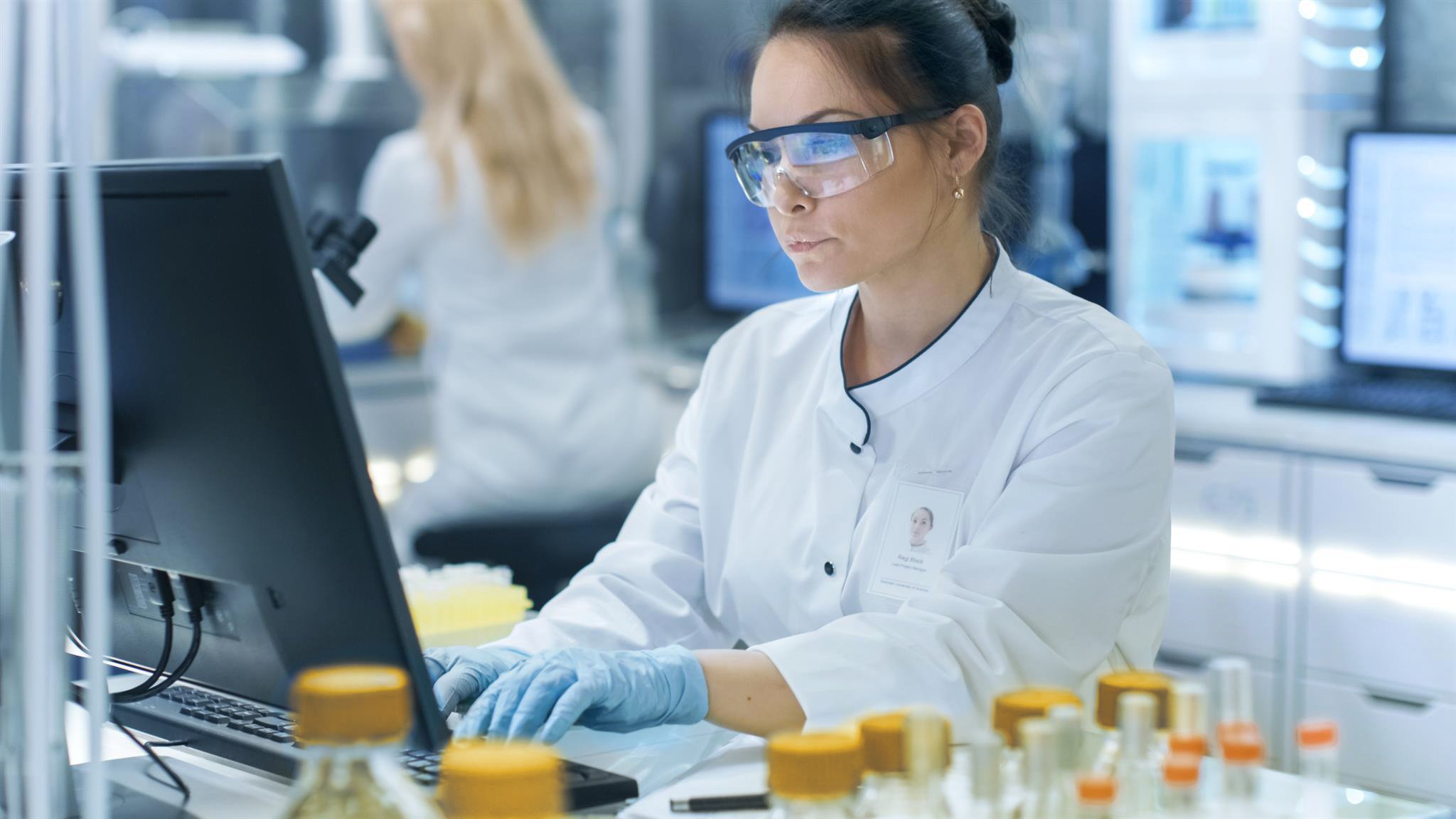Intertek Wilton's analytical support solutions driving robust data to enable clients' product development, regulatory submission, contamination, quality control or production issue resolution
SPECTROSCOPY & IMAGING
FTIR spectroscopy
Comprehensive range of IR sampling techniques for solids, liquids and gases including; Transmission, Attenuated Total Reflectance (ATR), Multiple Internal Reflection (MIR), Specular Reflectance, Photoacoustic spectroscopy (PAS), Diffuse Reflectance (DRIFTS), FTIR Microscopy (transmission and reflectance)
• FTIR Microscopy and mapping: analysis with ~10 micrometre spatial resolution (transmission) and up to ~3 micrometre depth resolution (μ-ATR)
• Variable Temperature Studies
• Surface-specific studies
• Near Infrared (NIR)
Raman spectroscopy - (532 nm, 633 nm, 660 nm and 785 nm laser excitation)
• Confocal Raman Microscopy with Fast Mapping: rapid production of chemical images with continuously tunable spatial resolution over range ~1-50 micrometer
• Depth Profiling
• Raman spectroscopy for process/in-situ analysis (lab scale reaction monitoring)
• Variable Temperature Studies
• Chemometric multivariate techniques for data analysis
UV-Visible spectroscopy
• Transmission and reflection.
• Integrating sphere for separation of diffuse and specular reflection components and analysis of turbid/scattering materials
MOLECULAR SPECTROSCOPY
We apply a range of techniques to identify and quantify components in mixtures. These can also be applied to deformulate products and identify the active species present.
Nuclear Magnetic Resonance (NMR) Spectrometry
• Pulsed NMR for liquids 500, 400 and 300 MHz spectrometers 1H, 13C, 31P, 27Al, 29Si, 15N ,19F nuclei (and others upon request)
• Modern 1-D and 2-D data processing
• GPC-NMR
• Access to Solid State NMR
• ACD 1H, 13C, 2D and Multinuclear Spectral prediction software
• ACD Database and IUPAC Name software
• QNMR
Mass Spectrometry (routine and high sensitivity)
• Hyphenated techniques including GC- MS, LC-MS, GC-MS-MS and LC-MS-MS
• Headspace GC-MS
• Thermal desorption-GC-MS
• Pyrolysis GC-MS
• Ionisation techniques include: EI, CI, ESI and APCI
• High resolution/accurate mass
SEPARATION SCIENCE
We regularly perform identification and quantitative analysis of organic compounds in various types of samples. We apply these approaches to investigate volatiles, involatiles and molecular weight distribution in polymer samples. We also use pyrolysis GC-MS for polymer identification or rubbers or cross-linked polymers.
Gas chromatography
• Gas chromatography (GC)
• Headspace GC
• Derivatisation techniques
Liquid Chromatography
• High Performance Liquid Chromatography (HPLC)
• UV+ELSD+FLD detection
• Gel permeation chromatography (GPC) including aqueous GPC
• High-Temperature GPC and room temperature triple detection GPC
INORGANIC & X-RAY ANALYSIS
Detection capabilities range from the ultra-trace to minor and major component levels involving quantitative, semi-quantitative or qualitative measurement interpretation modes.
X-Ray Fluorescence Spectrometry
• Wavelength Dispersive XRF
Atomic Spectrometry
• Dynamic Reaction Cell Inductively Coupled Plasma-Mass Spectrometry Microconcentric nebulisation
• ICP-OES (Dual View)
Combustion Techniques
• Microanalysis (C, H, N, O)
• Macroanalysis (C, S)
• Chemiluminescence (N)
• Microcoulometry (S, Cl)
• UV-Fluorescence (S)
Chemical Techniques
• Moisture
• Gravimetry
• Metal Assay
• Ion Chromatography (including gradient elution)
• Ion Selective Electrode
• pH
X-Ray Diffraction
Expertise in the analysis of inorganic, polymeric and composite materials
• Powder Diffraction and phase identification
• Capability for diffraction under controlled process conditions (temperature and environment)
Surface area
• BET method and porosity with nitrogen adsorption
Optical Microscopy
• All available optical techniques in both transmission and reflection.
• Hot Stage Microscopy
Laser Microscopy
• Confocal Laser Scanning Microscopy
• Three laser system (488, 543, 633)
Electron Microscopy
• SEM (high and low vacuum)
• SEM-EDX
• Environmental SEM
• Wet STEM
• Cryo-SEM
• TEM
Other Microscopy Services
• On-site sampling
• Legal Consultancy and expert witness
• Manual Image Analysis
• Contamination Audits
Particle Sizing
• Laser Diffraction – wet and dry
• Variable Fluids Module (0.04-2000um)
• Micro Volume Module (0.4-2000um)
• Dry Powder Module (0.4-2000um)
• Differential Centrifugal Sedimentation 2nm – 40um (density dependent)
Thermal Analysis
A wide range of thermal analysis methods are applicable to the investigation of thermal stability, physical properties, structure- property relationships, process history etc:
• Differential Scanning Calorimetry (DSC) and modulated-DSC
• Thermogravimetric Analysis (TGA)
• Thermomechanical Analysis (TMA)
• Dynamic Mechanical Analysis (DMA)
Mechanical Properties
• Stress-strain behaviour characterisation in tension, compression and flexure
• Mechanical testing in environments -50°C to 230°C
• Poisson’s Ratio
• Shore A, D, Rockwell & Barcol Hardness
• Izod & Charpy Impact Strength
• Tensile Creep & Fatigue testing
• Environmental Stress Cracking
• Adhesion tests
• % Haze, Light Transmittance, Gloss & Colour measurements.
• Water Vapour Transmission
• Surface Profilometry
• Chemical Resistance & Compatibility Testing
• Automotive Interior & Exterior Trim
• Sealant Testing
• Rubber Testing
Fracture Mechanics
• Linear elastic fracture mechanics
• Elastic-plastic fracture mechanics
Weathering & Exposure
• UV Exposure, Xenon Arc Weathering, Thermal Cycling, Humidity Resistance & Heat Ageing
Tribology
• Scratch, Mar Resistance, Crocking & Erichsen Scratch
• Taber & Linear Abrasion
• Coefficient of Friction
Rheology & processing (up to 400°C)
• Process simulation
• Capillary rheology – including transient extensional viscosity and laser die swell capability
• Rotational rheometry under both controlled strain rate and stress conditions
• Polymer melt-flow index

